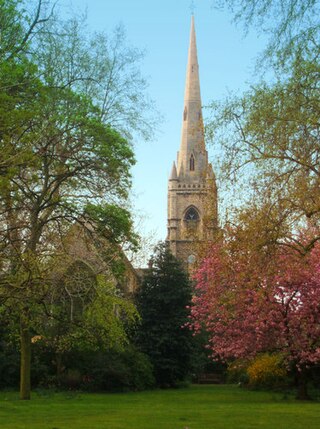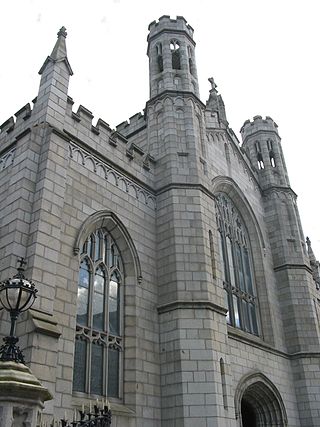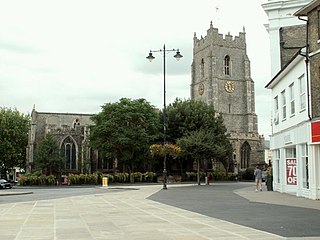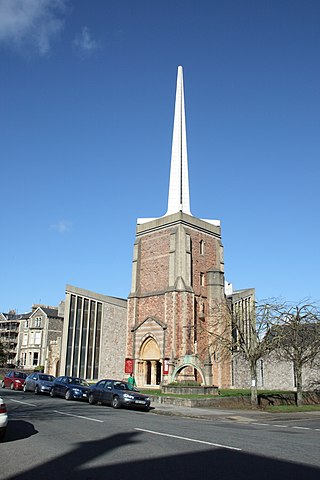
St. Michael and All Angels is the parish church for the town of Middlewich in Cheshire, England. It stands at the junction of the A54 and A533 roads. The church is recorded in the National Heritage List for England as a designated Grade II* listed building. It is an active Anglican parish church in the diocese of Chester, the archdeaconry of Chester and the deanery of Middlewich. Its benefice is combined with that of St John, Byley. In 1947 the architectural historian Raymond Richards described the church as "the one building, in a depressing town, which is mellow and dignified".

Holy Jesus Church at Lydbrook is a Church of England parish church in the English county of Gloucestershire.

St Peter's Church, Plemstall stands in an isolated position at the end of a country lane near the village of Mickle Trafford, Cheshire, England. It is recorded in the National Heritage List for England as a designated Grade I listed building. It is an active Anglican parish church in the diocese of Chester, the archdeaconry of Chester and the deanery of Chester. Its benefice is combined with that of St John the Baptist's Church, Guilden Sutton.

St Mary's Ecumenical Church is a Church of England / Methodist Local Ecumenical Project in the village of Weaverham, Cheshire, England. The church is the parish church of Weaverham and Acton Bridge and part of the Methodist Northwich and Winsford Circuit. The vision of the church is to share the light and hope of Jesus with the local community. The church building is recorded in the National Heritage List for England as a designated Grade I listed building. It is an active Anglican parish church in the Diocese of Chester, the archdeaconry of Chester and the deanery of Middlewich.

The Church of St Mary the Virgin is in Leek Road, Bosley, Cheshire, England. It is recorded in the National Heritage List for England as a designated Grade II* listed building. It is an active Anglican parish church in the diocese of Chester, the archdeaconry of Macclesfield, and the deanery of Macclesfield. Its benefice is combined with those of St Michael, North Rode, St Michael, Wincle, and St Saviour, Wildboarclough.

St Helen's Church is in the village of Tarporley, Cheshire, England. It is an active Anglican parish church in the diocese of Chester, the archdeaconry of Chester and the deanery of Malpas. Its benefice is united with those of St John and Holy Cross, Cotebrook, St Thomas, Eaton, and St Paul, Utkinton. The church is recorded in the National Heritage List for England as a designated Grade II* listed building.

St Matthew's Church is in the village of Stretton, Cheshire, England. The church is recorded in the National Heritage List for England as a designated Grade II listed building. It is an active Anglican parish church in the diocese of Chester, the archdeaconry of Chester and the deanery of Great Budworth. Its benefice is combined with that of St Cross, Appleton Thorn.
Thomas Cundy the younger was an English architect, son of another architect of the same name. He joined his father's practice and ultimately succeeded his father as surveyor of the Grosvenor Estate, and held the position during the main phase of the development of Belgravia and Pimlico by the contractor Thomas Cubitt.

St Gabriel's, Pimlico, is a Church of England, Anglo-Catholic parish church in Pimlico, London. It lies within the Deanery of Westminster within the Diocese of London. Designed by Thomas Cundy (junior), it was constructed between 1851 and 1853 as part of Thomas Cubitt's development of the area on behalf of the Marquess of Westminster. It is a Grade II* Listed Building.

The Cathedral of Saint Patrick and Saint Colman or Newry Cathedral is a Roman Catholic cathedral located in Newry, Northern Ireland. It acts as the seat of the Bishop of Dromore, and the Mother church of the Roman Catholic Diocese of Dromore. Prior to the COVID-19 pandemic, over 200,000 people visited the cathedral each year.

St Mary's Church is a redundant Anglican church in St Mary's Place, Shrewsbury, Shropshire, England. It is recorded in the National Heritage List for England as a designated Grade I listed building, and is under the care of the Churches Conservation Trust, the Trust designated St Mary's as its first Conservation Church in 2015. It is the largest church in Shrewsbury. Clifton-Taylor includes the church in his list of 'best' English parish churches.

The Parish Church of St Peter, Great Berkhamsted, is a Church of England, Grade II* listed church in the town of Berkhamsted, Hertfordshire, in the United Kingdom. It stands on the main High Street of the town and is recognisable by its 85-foot (26 m) clock tower.

St Peter'sChurch, Sudbury is a former Anglican church in the town of Sudbury, Suffolk, England, which now serves as an Arts Centre. The building is recorded in the National Heritage List for England as a designated Grade I listed building, and is under the care of the Churches Conservation Trust. The building stands in the heart of the town in a dominating position on Market Hill.

St Nicholas' Church, Sturry, is a joint Anglican and Methodist church standing on a bank beside the River Stour, in the village of Sturry, near Canterbury, in East Kent. The Local Ecumenical Partnership enables the congregation to be of mixed denomination - either Methodist or Anglican.

The Church of the Poor Clares dedicated to Assumption of the Blessed Virgin Mary is an historical church in Gdańska Street, Bydgoszcz, Poland.

St Mary's Church is a heritage-listed Roman Catholic church at 20 Merivale Street, South Brisbane, Queensland, Australia. It was designed by Simkin and Ibler and built from 1892 to 1929. It was added to the Queensland Heritage Register on 3 December 2004.

The Church of St John the Baptist is the parish church in the village of Royston in South Yorkshire, England. It is a Church of England church in the Diocese of Leeds. The building is Grade I listed and was built in the 12th century AD.

St. Procopius Church is a Roman Catholic church in Žďár nad Sázavou in the Czech Republic. It is protected as a cultural monument.

Immaculate Conception Church is a Roman Catholic Parish church in Spinkhill, Derbyshire, England. It was built in 1846 and designed by Joseph Hansom. It is situated on Spinkhill Lane opposite Immaculate Conception Catholic Primary School south of Mount St Mary's College in the village. It was founded by the Jesuits and is a Grade II listed building.

The Church of All Saints is a Church of England parish church in Clifton, Bristol. The church is a grade II listed building. It is located in the Parish of All Saints with St. John Clifton in the Diocese of Bristol.























